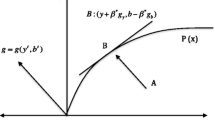Abstract
Under the assumption of “technology will not be forgotten,” this study estimates and decomposes the total-factor energy efficiency (TFEE) using the sequential data envelopment analysis-Malmquist productivity index and directional distance functions that consider undesirable output based on the provincial panel data of China from 2001 to 2013. On this basis, we make an empirical study of the relationship between foreign direct investment and energy efficiency with the dynamic panel model. The result shows that over the sample period, on the national level, the trend of the TFEE was upward, but the growth rate showed a downward trend. On the regional level, the TFEE in the eastern region was higher than that in the central and western regions. In addition, foreign direct investment enhanced the energy efficiency significantly, which demonstrated that the “pollution halo” effect was greater than the “pollution haven” effect. It is indicated that technical progress was the main cause of the increase in the TFEE, but technical efficiency played the opposite role. This conclusion remains valid even if the TFEE indicator is changed into the single-factor energy efficiency indicator.

Similar content being viewed by others
References
Chen DM, Zhang R, Tan ZY (2012) Total factor energy efficiency and regional economic convergence in China: an empirical analysis based on dynamic panel data model. China Popul Resour Environ 1:130–137
Chung YH, Färe R, Grosskopf S (1997) Productivity and undesirable outputs: a directional distance function approach. J Environ Manage 51(3):229–240
Doytch N, Narayan S (2016) Does FDI influence renewable energy consumption? An analysis of sectoral FDI impact on renewable and non-renewable industrial energy consumption. Energy Econ 54:291–301
Du LM (2010) Impact factors of china’s carbon dioxide emissions: provincial panel data analysis. South Econ 11:20–33
Fisher-Vanden K, Jefferson GH, Liu H et al (2004) What is driving China’s decline in energy intensity? Resour Energy Econ 26(1):77–97
Hübler M, Keller A (2010) Energy savings via FDI? Empirical evidence from developing countries. Environ Dev Econ 15(1):59
Li K, Qi SZ (2011) Trade openness, economic growth and carbon dioxide emission in China. Econ Res 11:60–72
Li K, Qi SZ (2013) Analysis of the transmission channel of FDI in China’s industrial energy efficiency-based on the level of forward and backward linkages. J China Univ Geosci (Soc Sci Ed) 4:27–33
Li MY, Xie JG, Zhang EZ (2014) Convergence analysis of the difference of regional energy efficiency in China-based on provincial panel data research. Econ Sci 1:23–38
Narayan S (2016) Predictability within the energy consumption-economic growth nexus: some evidence from income and regional groups. Econ Model 12:515–521
Newell RG, Jaffe AB, Stavins RN (1999) The induced innovation hypothesis and energy-saving technological change. Q J Econ 14(3):941–975
Qiu BY, Shuai X, Pei J (2008) Research on FDI technology spillover channels and Chinese manufacturing productivity growth: based on the panel data analysis. World Econ 8:20–31
Shestalova V (2003) Sequential malmquist indices of productivity growth: an application to OECD industrial activities. J Prod Anal 19(2–3):211–226
Shi D (2002) The improvement of energy consumption efficiency in China's economic growth. Econ Res 9:49–56
Sun PY, Wu LC, Chen SY (2011) On the nonlinear relationship between FDI and energy consumption intensity in an open economy: analysis based in the framework of environmental Kuznets curve. J Finance Econ 28:79–90
Teng YH, Chen XX (2009) An analysis of influential factors in China’s industrial sector energy intensity under open economy—an empirical analysis based on panel data models of the 31 industries. J Xinjiang Univ Finance Econ 1:15–20
Wang SL, Hu ZB (2012) Productivity changes and heterogeneity in China’s service sub-industry. Econ Res 4:15–27
Wu GY, Zhang JZ, Ji P (2004) Estimation of material capital stock in China: 1952–2000. Econ Res 10:35–44
Zhu PF, Zhang YJ, Guo L (2011) Empirical study of the relationship between FDI and environmental regulation: an intergovernmental competition perspective. Econ Res 6:133–145
Acknowledgments
This work is supported by the National Social Science Fund (Grant No. 16BGL140), the Jiangsu Social Sciences Fund (Grant No. 15EYC003), and the National Statistical Scientific Research (Grant No. 2015537).
Author information
Authors and Affiliations
Corresponding author
Rights and permissions
About this article
Cite this article
Wang, S. Impact of FDI on energy efficiency: an analysis of the regional discrepancies in China. Nat Hazards 85, 1209–1222 (2017). https://doi.org/10.1007/s11069-016-2629-x
Received:
Accepted:
Published:
Issue Date:
DOI: https://doi.org/10.1007/s11069-016-2629-x




